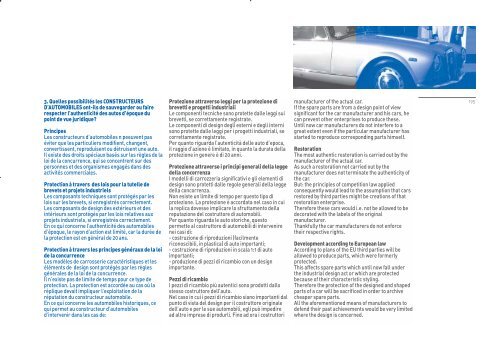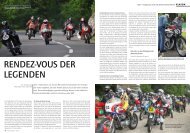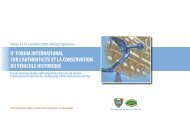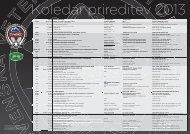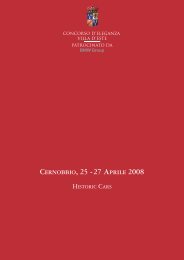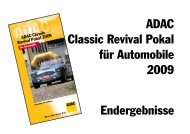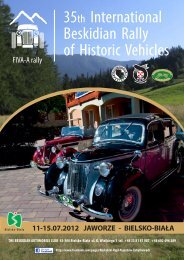FORUM INTERNATIONAL SUR L'AUTHENTICITE DU VEHICULE HISTORIQUE ...
FORUM INTERNATIONAL SUR L'AUTHENTICITE DU VEHICULE HISTORIQUE ...
FORUM INTERNATIONAL SUR L'AUTHENTICITE DU VEHICULE HISTORIQUE ...
You also want an ePaper? Increase the reach of your titles
YUMPU automatically turns print PDFs into web optimized ePapers that Google loves.
3. Quelles possibilités les CONSTRUCTEURS<br />
D’AUTOMOBILES ont-ils de sauvegarder ou faire<br />
respecter l’authenticité des autos d’époque du<br />
point de vue juridique?<br />
Principes<br />
Les constructeurs d’automobiles n peeuvent pas<br />
éviter que les particuliers modifient, changent,<br />
convertissent, reproduisent ou détruisent une auto.<br />
Il existe des droits spéciaux basés sur les règles de la<br />
loi de la concurrence, qui se concentrent sur des<br />
personnes et des organismes engagés dans des<br />
activités commerciales.<br />
Protection à travers des lois pour la tutelle de<br />
brevets et projets industriels<br />
Les composants techniques sont protégés par les<br />
lois sur les brevets, si enregistrés correctement.<br />
Les composants de design des extérieurs et des<br />
intérieurs sont protégés par les lois relatives aux<br />
projets industriels, si enregistrés correctement.<br />
En ce qui concerne l’authenticité des automobiles<br />
d’époque, le rayon d’action est limité, car la durée de<br />
la protection est en général de 20 ans.<br />
Protection à travers les principes généraux de la loi<br />
de la concurrence<br />
Les modèles de carrosserie caractéristiques et les<br />
éléments de design sont protégés par les règles<br />
générales de la loi de la concurrence.<br />
Il n’existe pas de limite de temps pour ce type de<br />
protection. La protection est accordée au cas où la<br />
réplique devait impliquer l’exploitation de la<br />
réputation du constructeur automobile.<br />
En ce qui concerne les automobiles historiques, ce<br />
qui permet au constructeur d’automobiles<br />
d’intervenir dans les cas de:<br />
Protezione attraverso leggi per la protezione di<br />
brevetti e progetti industriali<br />
Le componenti tecniche sono protette dalle leggi sui<br />
brevetti, se correttamente registrate.<br />
Le componenti di design degli esterni e degli interni<br />
sono protette dalle leggi per i progetti industriali, se<br />
correttamente registrate.<br />
Per quanto riguarda l’autenticità delle auto d’epoca,<br />
il raggio d’azione è limitato, in quanto la durata della<br />
protezione in genere è di 20 anni.<br />
Protezione attraverso i principi generali della legge<br />
della concorrenza<br />
I modelli di carrozzeria significativi e gli elementi di<br />
design sono protetti dalle regole generali della legge<br />
della concorrenza.<br />
Non esiste un limite di tempo per questo tipo di<br />
protezione. La protezione è accordata nel caso in cui<br />
la replica dovesse implicare lo sfruttamento della<br />
reputazione del costruttore di automobili.<br />
Per quanto riguarda le auto storiche, questo<br />
permette al costruttore di automobili di intervenire<br />
nei casi di:<br />
- costruzione di riproduzioni (facilmente<br />
riconoscibili, in plastica) di auto importanti;<br />
- costruzione di riproduzioni in scala 1:1 di auto<br />
importanti;<br />
- produzione di pezzi di ricambio con un design<br />
importante.<br />
Pezzi di ricambio<br />
I pezzi di ricambio più autentici sono prodotti dallo<br />
stesso costruttore dell’auto.<br />
Nel caso in cui i pezzi di ricambio siano importanti dal<br />
punto di vista del design per il costruttore originale<br />
dell’auto e per le sue automobili, egli può impedire<br />
ad altre imprese di produrli. Fino ad ora i costruttori<br />
manufacturer of the actual car.<br />
If the spare parts are from a design point of view<br />
significant for the car manufacturer and his cars, he<br />
can prevent other enterprises to produce these.<br />
Until now car manufacturers do not interfere to a<br />
great extent even if the particular manufacturer has<br />
started to reproduce corresponding parts himself.<br />
Restoration<br />
The most authentic restoration is carried out by the<br />
manufacturer of the actual car.<br />
As such a restoration not carried out by the<br />
manufacturer does not terminate the authenticity of<br />
the car.<br />
But: the principles of competition law applied<br />
consequently would lead to the assumption that cars<br />
restored by third parties might be creations of that<br />
restoration enterprise.<br />
Therefore these cars would i.e. not be allowed to be<br />
decorated with the labels of the original<br />
manufacturer.<br />
Thankfully the car manufacturers do not enforce<br />
their respective rights.<br />
Development according to European law<br />
According to plans of the EU third parties will be<br />
allowed to produce parts, which were formerly<br />
protected.<br />
This affects spare parts which until now fall under<br />
the industrial design act or which are protected<br />
because of their characteristic styling.<br />
Therefore the protection of the designed and shaped<br />
parts of a car will be sacrificed in order to archive<br />
cheaper spare parts.<br />
All the aforementioned means of manufacturers to<br />
defend their past achievements would be very limited<br />
where the design is concerned.<br />
195


